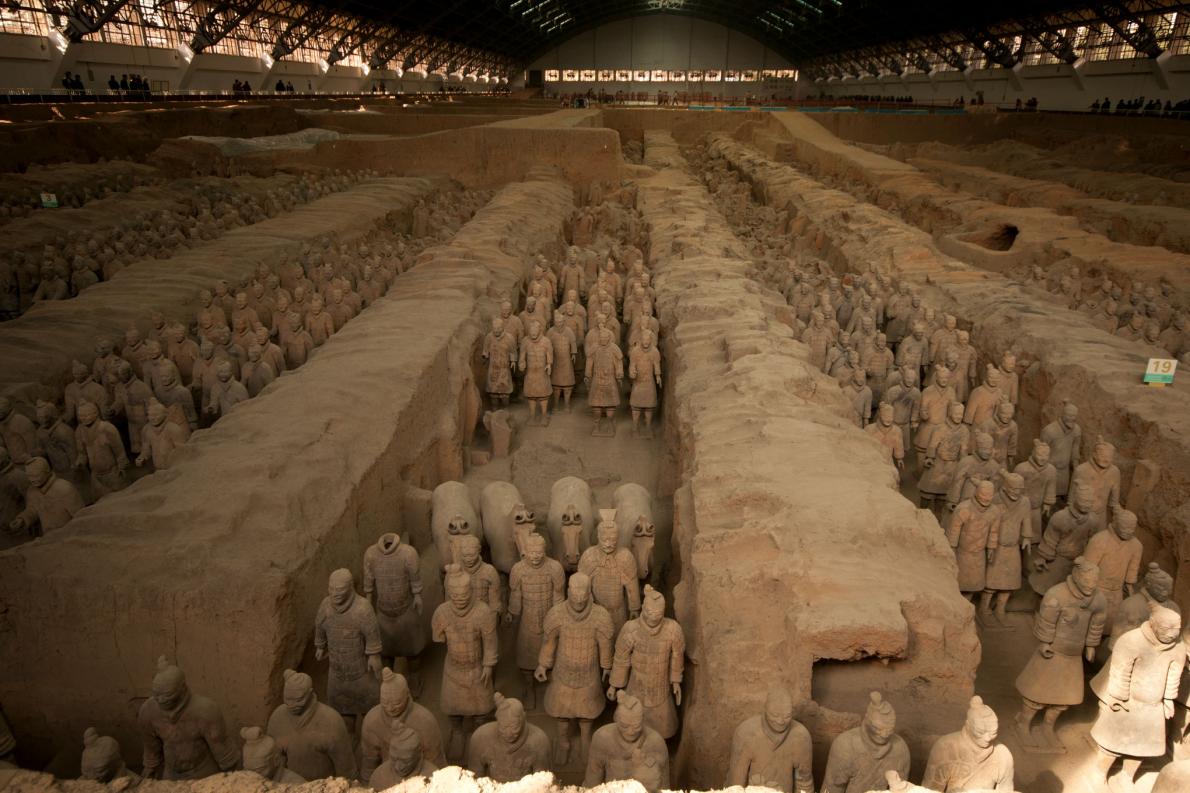On December 21, Delaware resident Michael Rohana donned a green sweater and a Phillies hat to attend a pre-Christmas party at the Franklin Institute in Philadelphia, Pennsylvania.
Around 9:15 that evening, surveillance footage allegedly shows Rohana and some friends sneaking into a closed exhibition. The exhibit, on-loan from China since September 30, 2017, contains 10 of the famous terra-cotta warriors, along with coins, gold pieces, jade, and weapons from the excavation site. Shortly after entering the exhibit, Rohana’s friends left, leaving the 24-year-old alone with the frozen warriors.
In the footage, Rohana views the exhibit using the glow from his smartphone flashlight. He appears to embrace one of the soldiers—called Cavalryman—and take a selfie with it. Then, Rohana puts his hand into the left hand of the figure. He allegedly breaks something off and stashes the terra-cotta memento in his pocket. Thumb in tow, he leaves the scene.
Museum staff didn’t realize the statue was missing an appendage until January 8, and they traced the alleged vandalism back to Rohana five days later. Authorities quickly showed up at his house, where he lives with his parents, and Rohana reportedly admitted that he had kept the disembodied thumb in a desk drawer in his bedroom.
THUMB THEFT
On January 13, Rohana was arrested and charged with theft and concealment of a major artwork, as well as interstate transportation of stolen goods. After surrendering his passport, he was released on bail on February 16.
The Shaanxi Cultural Heritage Promotion Center, who loaned the statues out to the Franklin Institute, “strongly condemned” the museum for being “careless.” The center also said it was going to send two experts to assess the damage and repair the statue with the recovered thumb. There would be a claim for compensation, it added.
Since the statues were discovered more than 40 years ago, the center has organized more than 260 overseas exhibits. But this is the first time a situation of this gravity has come to light.
“We call on the American side to severely punish the person who committed this destruction and theft of mankind’s cultural heritage,” an official told the Communist Party-affiliated Beijing Youth Daily.
The Franklin Institute said in a statement that its external security contractor did not follow standard closing protocol the night of the party, and the museum has reviewed its security measures and procedures to prevent future situations like this.
A TERRA-COTTA PAST
The Cavalryman statue is roughly 2,000 years old and was originally worth an estimated $4.5 million. It is part of a larger find of Emperor Qin’s Tomb, a terra-cotta tribute to China’s first emperor. Today, the UNESCO site is often referred to as one of China’s most important archaeological finds.
Chinese laborers came across strange terra-cotta fragments in 1974 when they were digging a well for an orchard outside the city of Xi’an. They then notified authorities, who returned to the site with government archaeologists. Over more than 40 years of excavation, they turned up part of a mausoleum for the country’s first emperor—Qin Shi Huang Di, or First Emperor of Qin.
Taking the throne shortly after his 13th birthday, Qin ruled from 246 to 210 B.C. He is credited with unifying the country’s warring kingdoms, ended feudalism, and built the first edition of the Great Wall of China.
Qin ordered for the mausoleum to be built shortly after he rose to power, and more than 700,000 laborers were put on the project. Construction lasted until 209 B.C., the year after Qin’s death.
There are four pits in the complex, and three of them are filled with 8,000 terra-cotta soldiers, though more may have existed some point. Each soldier, positioned according to rank, wears a different facial expression on its pink-pained face. Remnants of 2,000-year-old paint also show the warriors once had black hair and brown or black eyes, and were painted with shades of red, green, purple, and yellow to resemble brightly colored clothing.
Weapons and wooden chariots drawn by life-size clay horses are also among the three pits of ruins.
Qin’s tomb is still unexcavated, but Chinese archaeologists are using remote sensing, ground-penetrating radar, and core sampling to probe the mound. They’ve found that the tomb complex is 38 square miles in total.
Many others are buried at the site, including craftsmen, laborers, and criminals who died during construction. The skeletons of what are believed to be Qin’s many sons and executed concubines are remains in the mass grave.
Pit 1 was last excavated in 1985, but abruptly stopped after a worker stole a terra-cotta warrior’s head. The perpetrator was subsequently executed.













